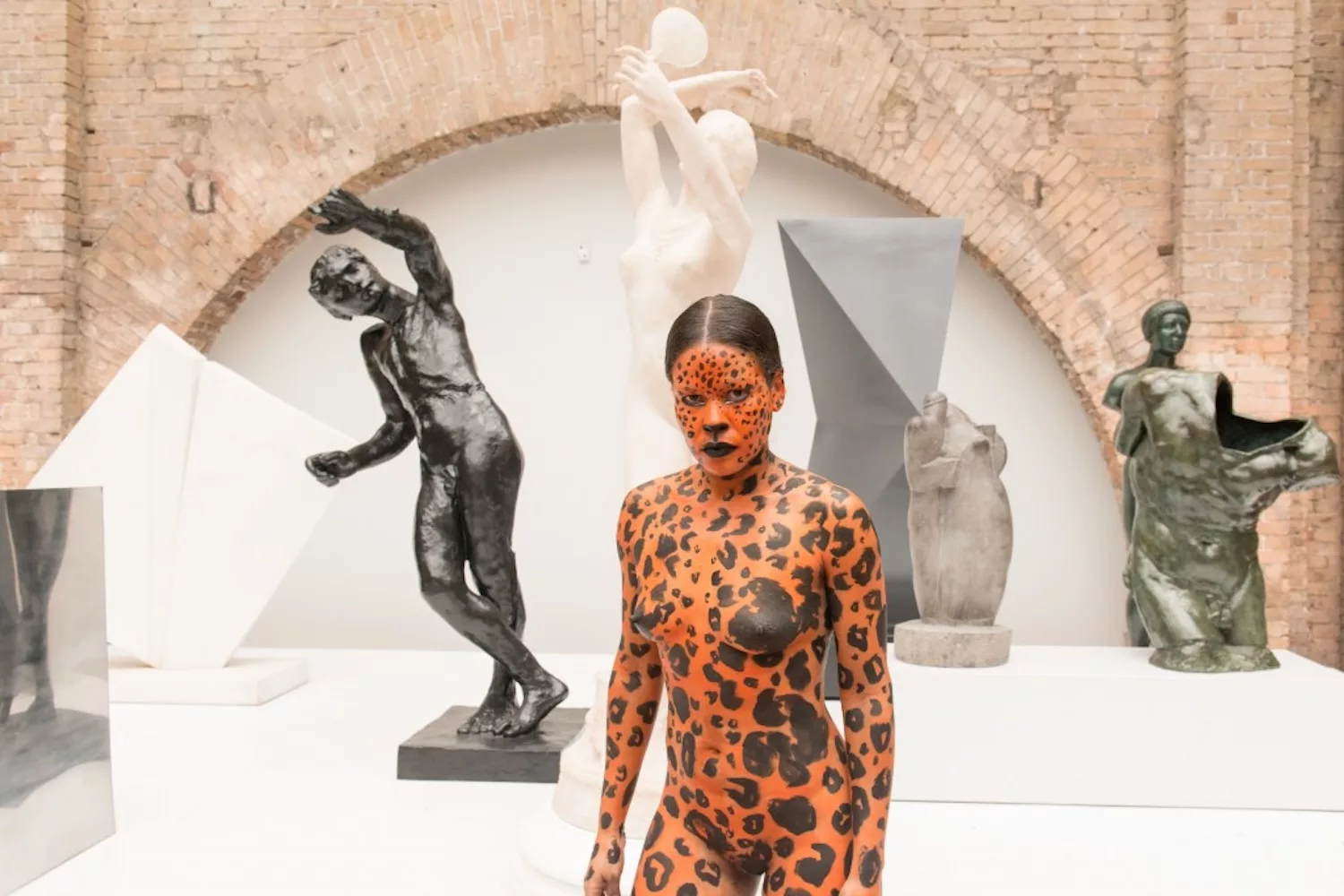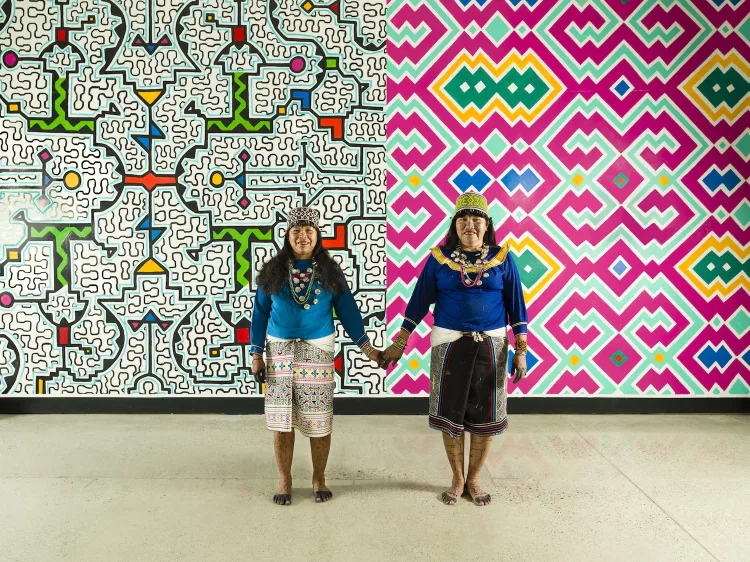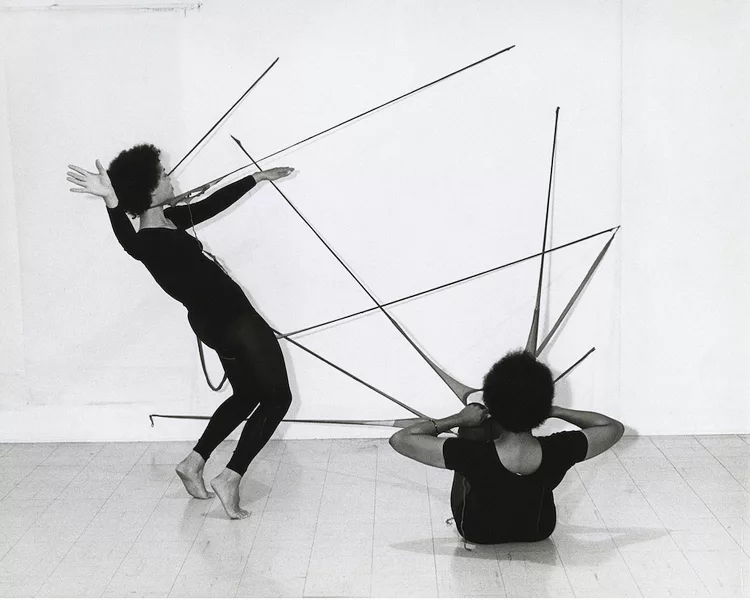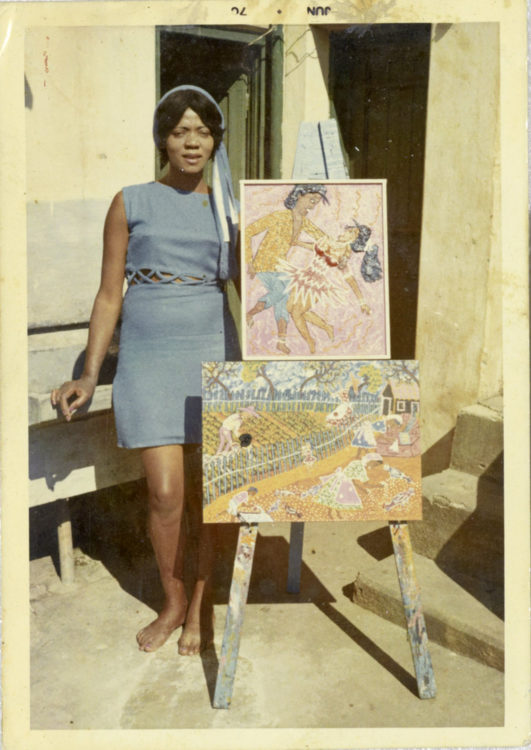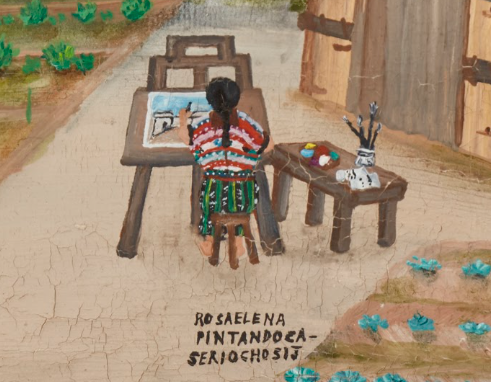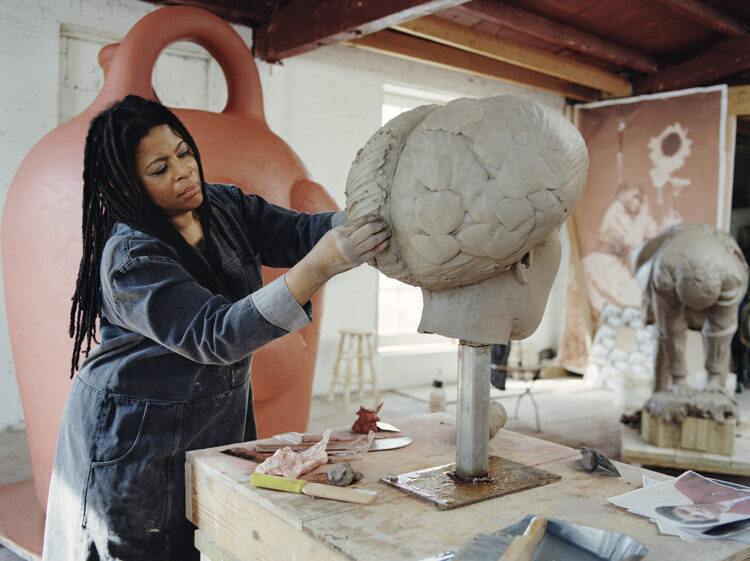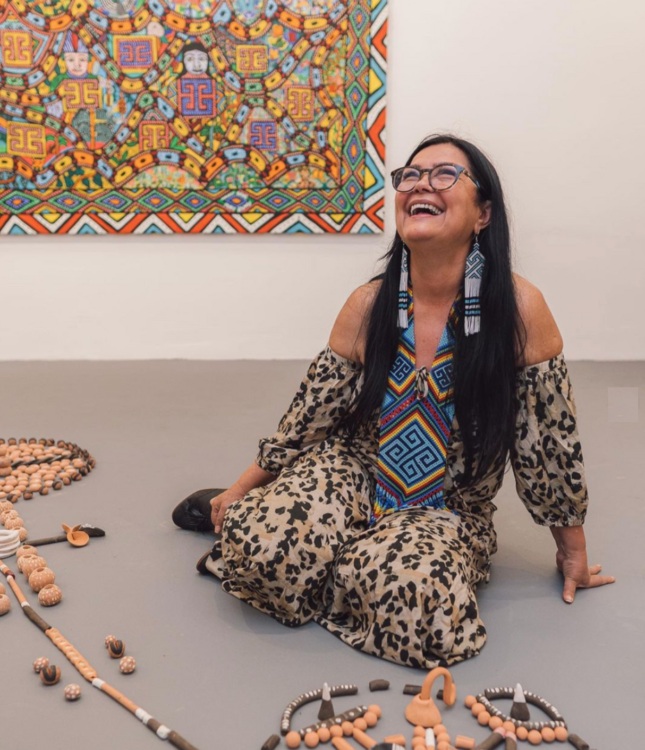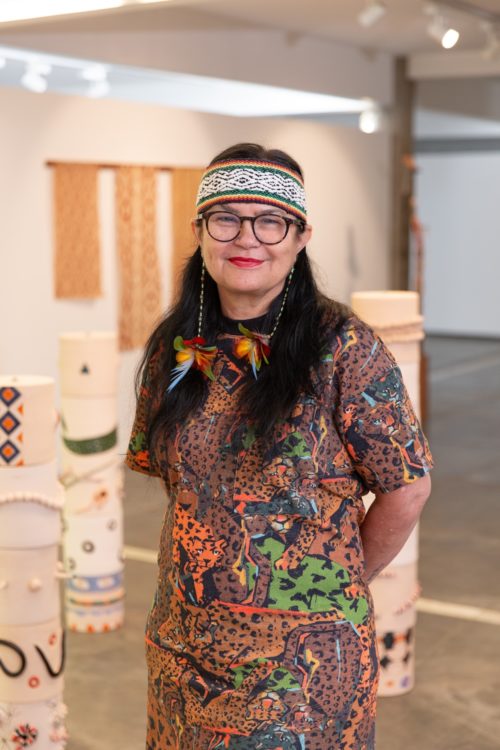Research
Like a hummingbird gathering pollen and spreading life, this text seeks to forge connections, driven by an urgent and ongoing personal reflection that defines me as an Indigenous woman artist. I wish I could think only through the forms and materials of art, but intangible, subjective questions haunt me—like ghosts I long to exorcise.
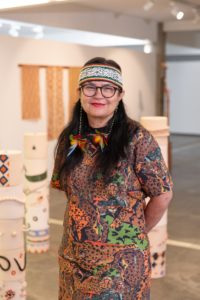
Kássia Borges Mytara © Photo: Bruna Miranda, Courtesy of the artist and of Carmo Johnson Projects
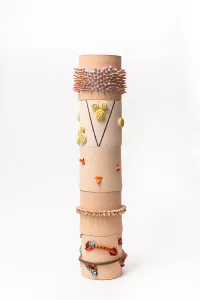
Kássia Borges, #3 from the series Rezo da mulher Pagé [Prayer of the Healer Woman], 2023, Painted ceramic, 103 × 20 cm, Courtesy of the artist and of Carmo Johnson Projects
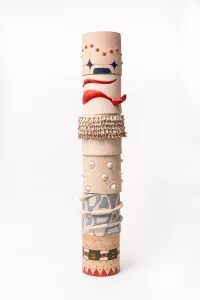
Kássia Borges, #14 from the series Rezo da mulher Pagé [Prayer of the Healer Woman], 2023, Painted ceramic, 103 × 20 cm, Courtesy of the artist and of Carmo Johnson Projects
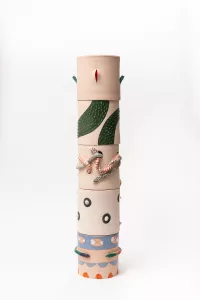
Kássia Borges, #20 from the series Rezo da mulher Pagé [Prayer of the Healer Woman], 2023, Painted ceramic, 103 × 20 cm, Courtesy of the artist and of Carmo Johnson Projects
I am Kássia Borges Mytara (1962–), an artist, curator, professor and Karajá activist. I have been involved in the production of what is known as ‘Brazilian indigenous art’ since the beginning of the 1980s – a time when such a designation was still little used. My primary mediums are painted canvas and ceramics. My connection to ceramics is organic, almost symbiotic, drawing equally from my childhood memories and the ancestral heritage of the Karajá people. Whether as standalone pieces or immersive installations, my often minimalist works function as fragments of a larger narrative. Through them, I address themes such as colonisation, violence against women – especially sexual violence – and the role of women in society, navigating between ethereal, personal and at times subjugated imaginaries.
For me, artistic installation is a tool for reclaiming both body and land. It engages the artwork, the viewer and the space in a shared movement – one that is deeply decolonial. Through this lens, I offer aesthetic reinterpretations of Indigenous creation myths, with a focus on those containing a feminine presence. My work seeks to give these narratives new meaning, restoring balance to the woman/man duality and rethinking the role of each in the foundations of society. I believe this perspective – one that challenges a world shaped by persistent masculinism – is essential. Perhaps my voice carries within it a ‘re-volta’, both revolt and return, or the cry of a woman marked by violence. On a personal level, I have transcended this position of suffering to become a shaman, a healer of pain. Since joining the MAHKU Collective – Movimento dos Artistas Huni Kuin [Huni Kuin Artists’ Movement] in 2018, I have devoted myself to healing through shamanic chants, transmuting them into pictorial imagery. In doing so, my practice weaves together memory, spirituality and creation into a unified vision.
We are witnessing a rupture in the cultural and institutional political approach to Indigenous arts. In this shifting landscape, museums and arts organisations have become spaces of critical reflection – places where outdated canons, which no longer relate to us or perhaps should never have been imposed on us, are being re-examined and redefined. Something new is being born. With change comes necessary deconstruction – but also reconstruction, an opening toward new possibilities, both for the present and the future. To fully grasp what is unfolding in Brazil’s artistic sphere today, we must step back, adopt a different perspective and critically engage with the past to envision what lies ahead. There is no light at the end of the tunnel without a clear and critical understanding of history – especially the history of art. The growing presence of Indigenous women in contemporary art exhibitions may seem self-evident today, but it is, in fact, the result of relentless struggles, collective action and a long, essential process of recognition.
Our emergence onto national and international stages marks a pivotal moment: through our work and our singular journeys, ancestral prayers and knowledge are disseminated. Our art is a cry of existence and for recognition. We are forging a new path, woven from a plurality of voices, a symphony of distinct repertoires. As masters of our arts and poetics, Indigenous women artists bring forth a richness of colours, forms and perspectives, with an undeniable urgency to be seen and heard. We cannot afford to be ignored again – especially in a world where colonisation, in various forms, continues to persist. I hold hope that this movement will take deep root, shifting perspectives, reinventing narratives and finally allowing our voices to be fully recognised.
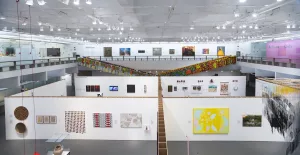
Exhibition view of Tempo Não Tempo [Time Non-Time], part of Histórias Indígenas [Indigenous Histories, 2023–2024], at the Museu de Arte de São Paulo Assis Chateaubriand (MASP), São Paulo
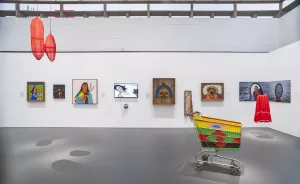
Exhibition view of Tempo Não Tempo [Time Non-Time], part of Histórias Indígenas [Indigenous Histories, 2023–2024], at the Museu de Arte de São Paulo Assis Chateaubriand (MASP), São Paulo
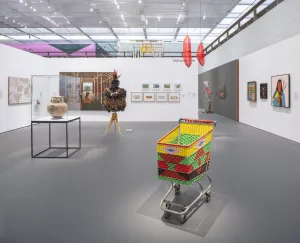
Exhibition view of Tempo Não Tempo [Time Non-Time], part of Histórias Indígenas [Indigenous Histories, 2023–2024], at the Museu de Arte de São Paulo Assis Chateaubriand (MASP), São Paulo
In 2023 I participated as both curator and artist in the Tempo Não Tempo [Non-Time Time] display, Brazil’s representation in the exhibition Histórias indígenas [Indigenous Histories, 2023–2024] at the São Paulo Assis Chateaubriand Art Museum (MASP). This exhibition brought together numerous Indigenous artists, and amongst them, I chose to highlight five women artists with distinct personal journeys, all connected by a shared focus: they centre the feminine universe at the heart of their artistic practices. These artists, coming from different generations and Indigenous communities, embody the diversity of perspectives and practices shaping this new reality.
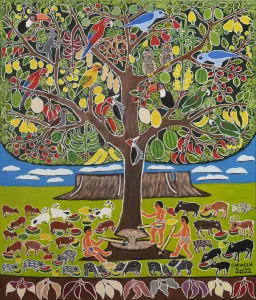
Carmézia Emiliano, Wakazá – A Árvore da Vida [Wazaká – Tree of Life], 2022, Oil on canvas, 70 x 60 cm, Museu de Arte de São Paulo Assis Chateaubriand, gift of Adriano Pedrosa, in memory of Selma Pedrosa, 2022, © Photo: Rodrigo Guedes da Silva
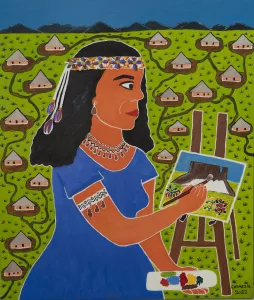
Carmézia Emiliano, Eu [I], 2022, Oil on canvas, 70 x 60 cm, Collection of the artist, Boa Vista, Roraima, © Photo: Rodrigo Guedes da Silva
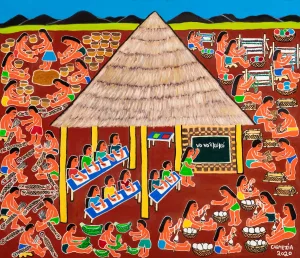
Carmézia Emiliano, Aprendendo [Learning], 2021, Oil on canvas, 60 x 70 cm, 2020, Museu de Arte de São Paulo Assis Chateaubriand, gift of the artist, © Photo: Eduardo Ortega
Carmézia Emiliano1 (1960–) was born in the Indigenous community of Maloca do Japó, in Roraima, and spent much of her life in traditional communal villages (aldeias). In 1990 she moved to Boa Vista, where she began painting as a self-taught artist in 1992. The question of ancestral wisdom and the exchange of knowledge lie at the heart of her compositions. Through them, C. Emiliano brings to life the daily practices and knowledge of the Macuxi people – especially those of the women, who serve as the primary guardians of these ancestral traditions.
Yaka Huni Kuin2 (1996–) initiates us into the concept of ancestrality through the eyes of the younger generation in contemporary Indigenous communal villages. As a member of MAHKU, her vibrant, richly textured work blends traditional techniques with a contemporary visual language. Primarily composed of paintings and drawings, her art depicts the symbols, myths and rituals of her people while also addressing the tensions surrounding Indigenous presence in urban spaces. Through her work, Y. Huni Kuin embodies a dynamic whereby contemporary Indigenous art is not merely an expression of individual poetic creation but emerges from the intersection of personal performance and collective heritage.
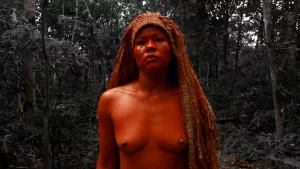
Olinda Yawar Tupinambá, Equilíbrio [Balance], 2020, Video installation composed of soil and seeds, Courtesy of the artist
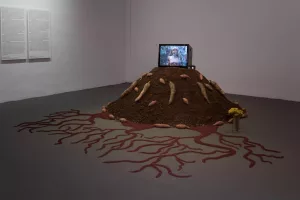
Olinda Yawar Tupinambá, Equilíbrio [Balance], 2020–2024, Video installation composed of soil and seeds, Courtesy of the artist, © Photo: Rafa Jacinto / Fundação Bienal de São Paulo
Olinda Yawar Tupinambá3 (1989–), from the Tupinambá and Pataxó-hã-hã-hãe peoples, was born on the Caramuru-Paraguassu terra indígena, in the state of Bahia. A filmmaker, documentarian, journalist, ecological activist and artist, she employs contemporary tools and languages – such as video and cinema – to explore the impacts of colonisation on Indigenous lands. Her work in performance and video installations urges the public to reflect on the current realities of Indigenous peoples, while drawing attention to their ongoing struggles to preserve their territories and culture. At the core of her work, she reclaims a central space for women, placing them at the forefront of the narrative.
Finally, Yacunã Tuxá4 (1993–) and Uýra Sodoma5 (1991–) raise hitherto unasked questions about gender and sexuality in the imaginaries of Indigenous art. Y. Tuxá is from the terra indígena Tuxá de Rodelas, in the north of Bahia. Her work addresses gender within the ancestral territory, forging a dialogue between the traditions of her people and contemporary questions surrounding gender identity. She explores the ways in which notions of masculinity and femininity are experienced within the framework of indigenous cultures, while questioning the roles these constructs play in broader narratives of resistance and reinvention. Meanwhile, U. Sodoma offers a radical reflection on the trans and hybrid body. As she metamorphoses herself into person-tree, person-animal, person-water and person-earth, her art transcends the boundaries of the human body to embrace a fluid identity, intimately connected with nature. By turning her body into a living organic form, she bridges the human and non-human worlds. Through performances and installations, U. Sodoma not only speaks to the majesty of the Amazon rainforest but also raises awareness amongst non-Indigenous audiences of deforestation and the environmental and climate crises threatening our planet’s delicate equilibrium. Her work is a cry of resistance, of interconnection and of vigilance in the face of ecological destruction while offering a radical alternative to binary conceptions of both the body and nature.
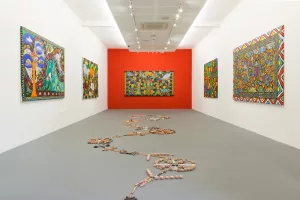
Exhibition view, Chants of Images – MAKHU, Casa de Cultura do Parque, São Paulo, July 2 – September 18, 2022, © Photo: Samuel Esteves, Courtesy of the artist and of Carmo Johnson Projects
What defines Indigenous art? Is it the identity of those who create it, or the themes, poetics and aesthetics that drive it? Can we truly speak of a ‘contemporary Indigenous art’? As Indigenous artists, we bear witness to our time, our struggles and our wounds, embedding our work in the present. If contemporary art – by Western definitions – is inseparable from life, then we have always been contemporary. For us, there has never been a division between art and existence: our lives are interwoven with artistic expression, whether through body painting, everyday objects or the rituals that carry forward our stories and knowledge. Examining the themes explored by Indigenous women artists reveals a striking commonality in their works – a shared current that unites us as carriers of critical thought. Through our artistic practice, we transform the history of our struggles into acts of resistance and affirmation. Rooted in contemporary fights for environmental preservation and Indigenous rights, our art becomes a powerful force for challenging and redefining history. In my view, this form of expression – deeply engaged with social, political, and environmental issues – is an ‘artivism’. It is not confined to a single territory but resonates both in Brazil and internationally, awakening consciousness and fostering critical reflection on the urgent issues of our time.
CARNEIRO, Amanda (org), Carmézia Emiliano: A árvore da vida [The Tree of Life], São Paulo, MASP, 2023.
2
PEDROSA, Adriano e GIUFRIDA, Guilherme, MAHKU, Movimento dos Artistas Huni Kuin: Mirações, São Paulo, MASP, 2023.
3
Also known as Olinda Muniz Silva Wanderley. https://www.premiopipa.com/olinda-yawar-tupinamba/
4
PEDROSA, Adriano e GIUFRIDA, Guilherme, Histórias indígenas [Indigenous Histories], São Paulo, MASP, 2023.
5
UÝRA
Kássia Borges Mytara (1962–) is a shaman, artist, curator, researcher, teacher and Karajá activist. In her primarily ceramics-based practice, she confronts themes such as indigenous resistance, women and genealogy. She is also a member of the collective MAHKU – Movimento Dos Artistas Huni Kuin [Huni Kuin Artists Movement]. She has worked at the Museu do Índio in Uberlândia since 1987 and joined the board of curators of the São Paulo Assis Chateaubriand Art Museum (MASP) in 2022. As an artist, she participated in the São Paulo and Venice Biennales in 2023–2024.
Kássia Borges Mytara, "To create and heal. The artivism of Brazilian Indigenous women artists." In Archives of Women Artists, Research and Exhibitions magazine, . URL : https://awarewomenartists.com/en/magazine/creer-et-guerir-lartivisme-des-artistes-autochtones-au-bresil/. Accessed 13 December 2025
